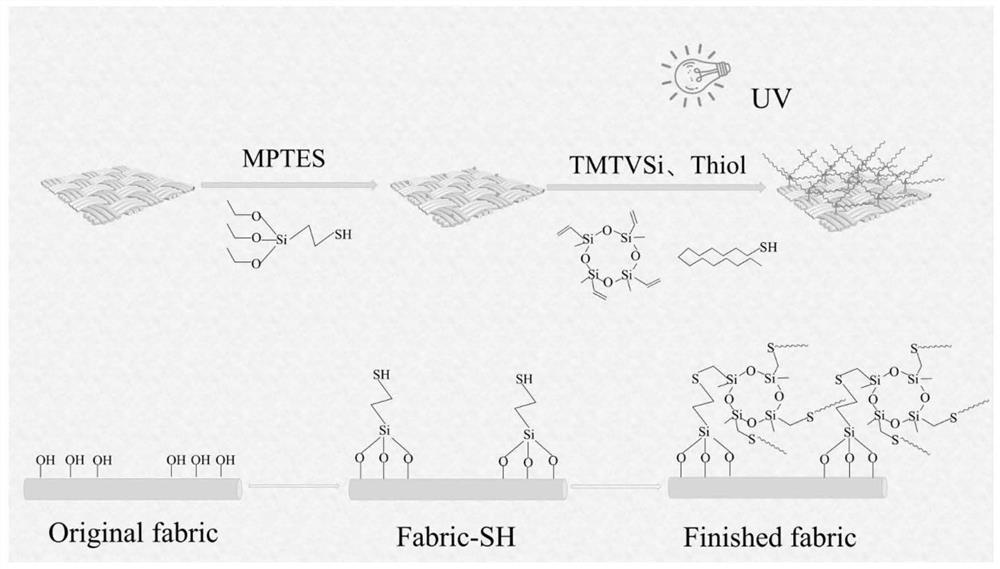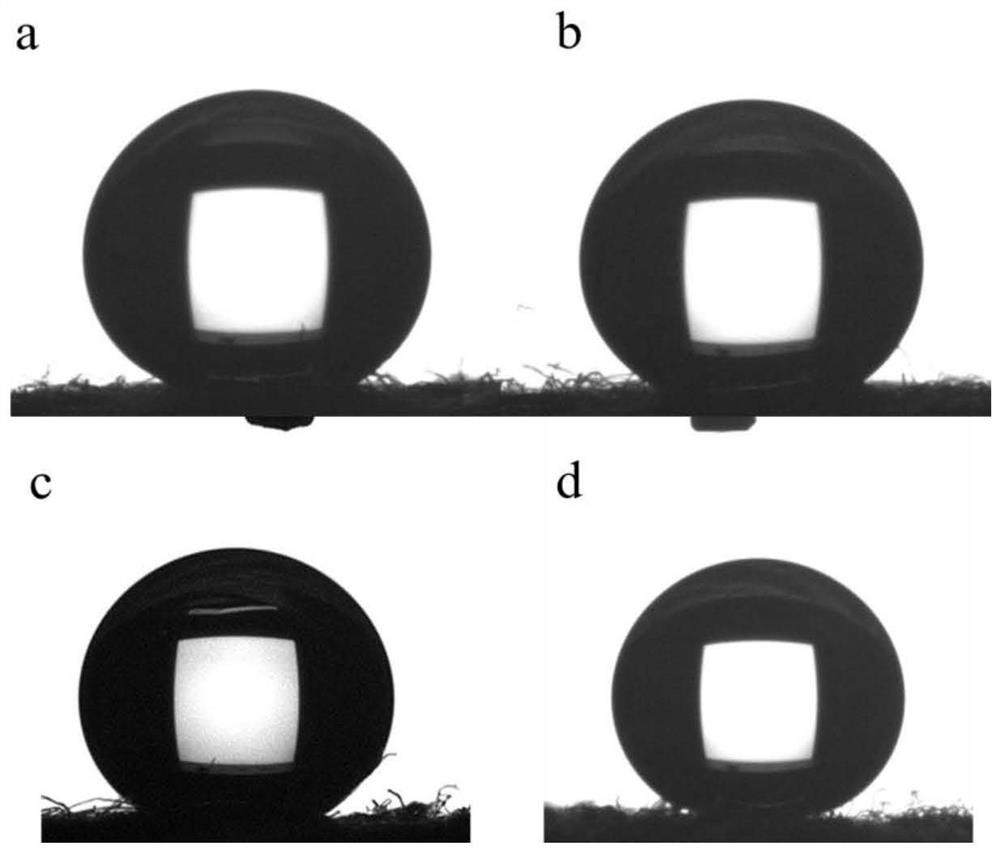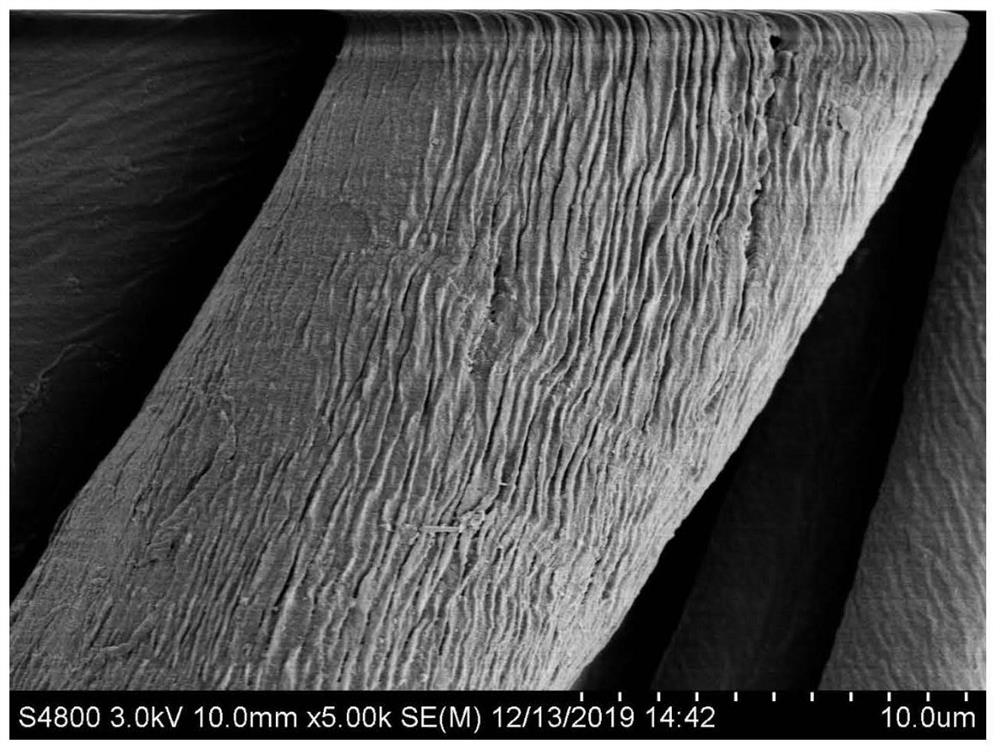A method for preparing superhydrophobic cotton textiles by mercapto-ene click chemical modification
A super-hydrophobic cotton, chemical modification technology, applied in textiles and papermaking, abrasion-resistant fibers, light-resistant fibers, etc., can solve the problems of actual manufacturing trouble, damage to the ecological environment, complicated and cumbersome manufacturing methods, etc., and achieve good acid resistance. Alkali, improve hydrophobicity, improve the effect of roughness
- Summary
- Abstract
- Description
- Claims
- Application Information
AI Technical Summary
Problems solved by technology
Method used
Image
Examples
Embodiment 1
[0030] Step 1. Cotton fabric pretreatment: Experimental formula: cotton cloth 10cm×10cm, 100°C, soap flakes 2g / L, Na 2 CO 3 5g / L, liquor ratio 1:50, 30min, vacuum drying at 70℃. After drying, take out, and use acetone, ethanol, and deionized water to ultrasonically clean the cotton fabric in sequence. Ultrasonic cleaning is performed in each solvent for 15 minutes. After cleaning, the cloth sample is taken out and dried.
[0031] Step 2, cotton fabric modification treatment: put the pretreated cotton fabric into a dyeing cylinder, add 0.3 mL of MPTES, and react in an infrared dyeing machine at 90° C. for 90 min. Take out the cloth sample, put it in a conical flask, add 100 mL of absolute ethanol to clean it, shake it in a small sample machine at 25 °C for 4 hours, take it out, wash it with deionized water, and dry it in a vacuum at 80 °C.
[0032] Step 3, mercapto-ene click chemical hydrophobization of modified cotton fabric: Cut the modified cotton fabric into a 5cm×5cm sw...
Embodiment 2
[0034] Step 1. Cotton fabric pretreatment: Experimental formula: cotton cloth 10cm×10cm, 100°C, soap flakes 2g / L, Na 2 CO 3 5g / L, liquor ratio 1:50, 30min, vacuum drying at 70℃. After drying, take out, and use acetone, ethanol, and deionized water to ultrasonically clean the cotton fabric in sequence, ultrasonically clean for 15 minutes in each solvent, take out the cloth sample after cleaning, and dry.
[0035] Step 2, cotton fabric modification treatment: put the pretreated cotton fabric into a dyeing cylinder, add 0.3 mL of MPTES, and react in an infrared dyeing machine at 90° C. for 90 min. Take out the cloth sample, put it in a conical flask, add 100 mL of absolute ethanol to clean it, shake it in a small sample machine at 25 °C for 4 hours, take it out, wash it with deionized water, and dry it in a vacuum at 80 °C.
[0036] Step 3, mercapto-ene click chemical hydrophobization modified cotton fabric: Cut the modified cotton fabric into a 5cm×5cm swatch, remove the burr...
Embodiment 3
[0042] Step 1. Pretreatment of cotton fabric: Experimental formula: cotton cloth 10cm×10cm, 100°C, soap flakes 2g / L, Na 2 CO 3 5g / L, liquor ratio 1:50, 30min, vacuum drying at 70℃. After drying, take out, and use acetone, ethanol, and deionized water to ultrasonically clean the cotton fabric in sequence. Ultrasonic cleaning is performed in each solvent for 15 minutes. After cleaning, the cloth sample is taken out and dried.
[0043] Step 2, cotton fabric modification treatment: put the pretreated cotton fabric into a dyeing cylinder, add 0.3 mL of MPTES, and react in an infrared dyeing machine at 90° C. for 90 min. Take out the cloth sample, put it in a conical flask, add 100 mL of absolute ethanol to clean it, shake it in a small sample machine at 25 °C for 4 hours, take it out, wash it with deionized water, and dry it in a vacuum at 80 °C.
[0044] Step 3, mercapto-ene click chemical hydrophobization of modified cotton fabric: Cut the modified cotton fabric into a 5cm×5cm...
PUM
| Property | Measurement | Unit |
|---|---|---|
| contact angle | aaaaa | aaaaa |
| contact angle | aaaaa | aaaaa |
| contact angle | aaaaa | aaaaa |
Abstract
Description
Claims
Application Information
 Login to View More
Login to View More - R&D
- Intellectual Property
- Life Sciences
- Materials
- Tech Scout
- Unparalleled Data Quality
- Higher Quality Content
- 60% Fewer Hallucinations
Browse by: Latest US Patents, China's latest patents, Technical Efficacy Thesaurus, Application Domain, Technology Topic, Popular Technical Reports.
© 2025 PatSnap. All rights reserved.Legal|Privacy policy|Modern Slavery Act Transparency Statement|Sitemap|About US| Contact US: help@patsnap.com



